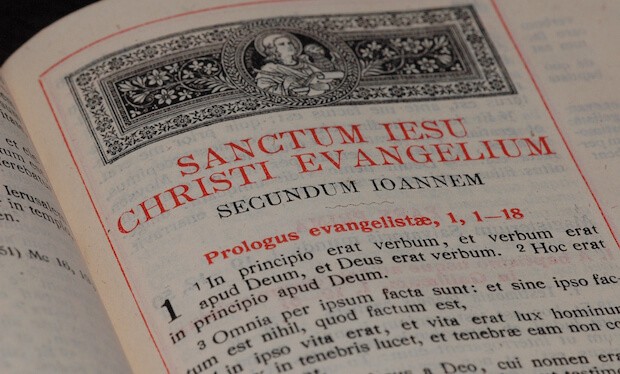Following the Council of Trent in the sixteenth century, the Latin Vulgate became the official Latin Bible of the Roman Catholic church—and that after centuries of dominance as the preferred Bible of the Western world. The Reformation revived interest in the original languages, and a slew of new translations followed. Following that, Protestantism largely left the Vulgate behind. But this ancient translation still has much to offer the serious student of the Bible, providing a unique glimpse into lost manuscripts undergirding modern translations, and illuminating how great theologians like John Calvin referenced Scripture.
I sat down with Andrew Curtis, a Latin-language editor at Faithlife and co-editor of the forthcoming The Lexham Latin-English Interlinear Vulgate Bible. He explained the history of the Vulgate, it’s importance for Bible study, and how Lexham’s new Interlinear opens up the Vulgate to anyone—even if they don’t know Latin.
Tell us a little about the history of the Vulgate and how it was put together.
In the year 382, the great patristic biblical scholar Jerome was asked by Pope Damasus to revise the old Latin translation of the Gospels in light of the original Greek. Within a few years Jerome also ended up producing two different revised translations of the Psalms. Later, from AD 390 to 405, Jerome translated the Hebrew Scriptures into a new Latin version generally credited as the first direct Hebrew-to-Latin translation.
Prior to this time, virtually the whole Bible existed in Latin, but it was a patchwork of different translations. By translating the whole Hebrew canon afresh and revising portions of the New Testament and the deuterocanonical books, Jerome standardized the Latin Bible, put it all in one place. It was an unprecedented feat. The Vulgate is still a composite text, with some books preserving their old Latin form more or less unrevised, but Jerome’s translation brought a new consistency to the style and vocabulary of Scripture while remaining close to the letter of the original languages. This is a point worth emphasizing—the Latin Vulgate makes the whole Bible into a single linguistic corpus, bridging the language gap between the New and Old Testaments.
You’ve mentioned to me that the Vulgate can be really helpful for textual criticism and original-language study. Why is that?
Well, for one thing, Jerome had access to the best manuscripts out there in the fourth century. When he compiled, translated, and revised the texts that would become the Vulgate, he was able to consult manuscripts that were already ancient in his time. He traveled to Rome and Bethlehem and accessed the knowledge and manuscripts of the great rabbis. It was a sophisticated process.
Most exciting for text-critical study is the fact that the Vulgate gives important insights into the text of Hebrew and Greek manuscripts now lost. The Vulgate is in many ways a transparent translation; the original languages shine through, offering a window into the readings of the manuscripts available in Jerome’s day. So in critical editions of the Septuagint, the Hebrew Scriptures, and the Greek New Testament, the Vulgate is often consulted for its value as a secondary witness to the original languages. For instance, the 1917 translation of the Tanakh by the Jewish Publication Society used the Vulgate as one of its sources.
Is the average Protestant pastor or seminary student going to get anything out of studying the Vulgate?
Definitely. The Vulgate was the basis of most Latin scriptural quotations in the Middle Ages, the Renaissance, and the Reformation. Many people who study the Bible all the time don’t often think about the fact that the Vulgate is the Bible Martin Luther grew up with! There were vernacular translations before Luther, but most literate people at the time used the Vulgate as their Bible. Biblical commentary and exegesis as well as secular literature commonly drew on the Vulgate: John Calvin, Theodore Beza, and Thomas Hobbes all quote it in Latin. Even into the twentieth century, the Vulgate was the nearly universal source of Latin scriptural references in scholarly discourse.
Further, the Vulgate can help bridge the gap between the Old and New Testaments. You have to breathe with both lungs as a Christian. You have to incorporate both the Old and New Testaments. Every Christian knows that concepts carry over from the Old Testament into the New—grace, the Spirit, hospitality, love, justification, and much more. To establish linguistic correspondences when studying those concepts, the Latin Vulgate is very helpful because, as I mentioned before, it’s linguistically unified.
You’re one of the editors working on the new Lexham Vulgate interlinear and reverse interlinear. Talk a little bit about what these are, and why Logos users should be excited for them.
The Lexham Latin-English Interlinear Vulgate Bible will include hand-tagged Latin lemmas, morphology, and English lexical glosses for both the New and the Old Testament. The benefits of this linguistic data go both ways: if you know some Latin, the interlinear will help you delve more deeply into the Vulgate, providing quick information on unfamiliar words or forms and helping you find out where and how particular words are used throughout Scripture; if you’re not proficient in Latin, the glosses allow you to search in English to discover the corresponding Latin words; then the lemma and morphology tags help you understand how the Latin is working, making it easy to tap into the Vulgate text and compare it, for example, to one of the many vernacular translations based on or influenced by the Vulgate (e.g. the Wycliffe Bible).
The Lexham Reverse Interlinear Vulgate Bible will be especially exciting if you are interested in textual criticism and original-language study. Bringing reverse interlinear functionality to the Latin Vulgate is a big deal. This new feature will give you the same kind of original-language information for Greek and Hebrew that you would get in your KJV reverse interlinear, but the “surface text” on the top line will be Latin rather than English and will come with complete Latin lemma and morphology tagging. Since the Vulgate has been one of the most historically influential translations of the Bible after the Septuagint, this is an important new contribution to the field of biblical studies. To my knowledge, there is no other Vulgate resource of this kind currently on the market.
That means you had to develop a Latin morphology to match the Greek and Hebrew morphology Logos already uses.
Yes. We already have well-established models for categorizing the morphology of Greek and Hebrew. That’s the data that drives the word studies and search functionality of Logos. It’s the kind of data that lets you run complex queries like, “Where does this word in this form appear throughout the Bible? How is it translated?” Those sorts of questions existed long before Bible software, of course, and we used some of the pre-existing morphological systems as we built Logos. But we now also have our own morphology for Greek and Hebrew. My task is to help refine a similar framework that we have developed for Latin morphology over the past few years.
How will the work you’re doing now be applied in the future?
Well, obviously the Bible is the central text for what we do at Faithlife. So having Latin morphology integrated with the text of Scripture will be huge for us. Our Latin morphology, though, can also be carried over and applied to other Latin resources in the future—the framework will all be there. I wish I had had the language-study tools that our software provides when I was a Latin student digging into Virgil’s Aeneid for the first time. These tools have a lot to offer people reading and studying texts of all kinds.
***





